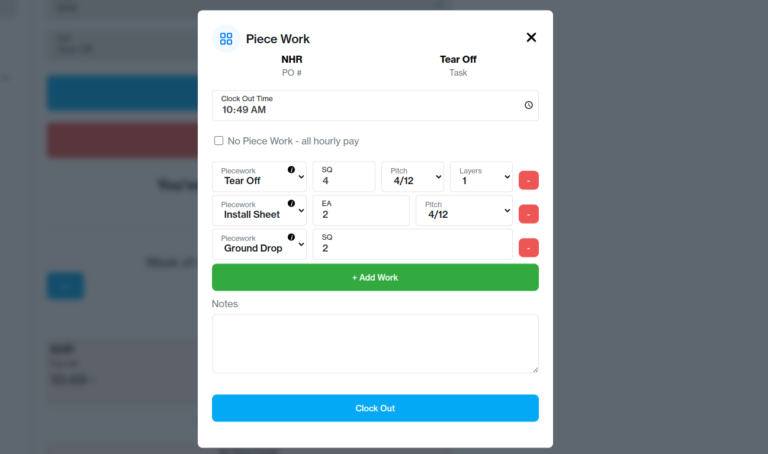Understanding Piece Work (or Piece Rate Pay): A Simple Guide
Table of Contents
- What Is Piece Work (or Piece Rate Pay)?
- How Piece Rate Differs from Hourly Pay
- Why Piece Work Can Be Helpful
- Common Problems to Watch Out For
- Steps to Start a Piece Rate System
- Is Piece Work Right for Your Business?
- Final Thoughts & Next Steps
1. What Is Piece Work (or Piece Rate Pay)?
Piece work, also called piece rate pay, is a way of paying people for the amount of work they finish rather than the number of hours they spend on a job. For example, a person in a factory might get paid for each item they produce, or a roofer might earn money for each square of shingles they install. If they complete more items or install more squares, they earn more.
This idea has been around for a very long time. Farmers often used it to pay workers for how many baskets of crops they picked. Over time, piece rate spread to other jobs like construction, cleaning, and manufacturing. Many businesses like it because it can encourage workers to do more or do it faster, as their pay goes up when they complete more tasks.
But it is not just about speed. Quality also matters. If people do sloppy work, it can cause problems for the business or the customers. That is why most companies using a piece work system also check the quality of what gets done.
2. How Piece Rate Differs from Hourly Pay
Time vs. Output
- Hourly Pay: When someone is paid by the hour, they get a fixed amount of money for each hour they work. It does not matter how many tasks they finish in those hours; they will still get the same hourly rate.
- Piece Rate Pay: In a piece rate system, the person’s pay depends on how many units or tasks they complete. The more they do, the more they earn.
Why It Matters
- Motivation: People paid by the hour might not feel the need to work as quickly or efficiently. On the other hand, people paid per piece often want to produce more because it boosts their pay.
- Tracking: Hourly pay is simple to track—just record the start and end time. Piece work requires you to count each unit completed, which can be a bit more work for managers.
- Overtime Rules: Some regions have laws about overtime. Even if you pay by the piece, you still need to follow rules about minimum wage or extra pay for hours beyond a certain limit.
3. Why Piece Work Can Be Helpful
Higher Productivity
In a piece rate system, workers see a direct link between how much they do and how much they earn. This can make them want to work faster or more carefully. They know that each item completed or task finished adds to their total pay. Many businesses notice that when they switch to piece work, their output goes up.
Cost Control
With piece rate, it can be easier to plan your costs. If you know each piece costs a certain amount, you can figure out how much money the project will cost in labor. For example, if you run a roofing company, you can calculate the cost by the number of squares installed. If you make clothing in a factory, you can calculate the total cost by how many garments workers complete.
Fair Rewards
Some people work faster than others. In an hourly system, a quick worker and a slow worker might earn the same pay if they both work the same number of hours. In a piece work system, the faster or more skilled worker earns more because they finish more units. This can feel fairer to those who put in extra effort or have special skills.
Less Micromanagement
When workers earn more for each piece they complete, they often manage themselves. Supervisors spend less time telling them what to do because the pay system already motivates them. This can free up managers to work on other tasks, such as planning, quality checks, or even training.
4. Common Problems to Watch Out For
Quality Concerns
When people try to work quickly, they might sometimes rush. If your system only rewards speed, you might see more mistakes or lower-quality products. To fix this, many businesses have quality checks. For example, you might require each finished item to pass inspection. If someone’s work has too many mistakes, they may not get paid for those faulty items.
Uneven Skills or Training
Not everyone works at the same pace or skill level. New employees may feel stressed if they cannot match the speed of more experienced workers. They might worry they will not earn enough. Good training and a fair piece rate can help them catch up and feel more confident.
Tracking Each Piece
Figuring out how many pieces each worker completes can be harder than simply adding up their hours. Some companies use piece work software or special apps to track how much each person finishes. This helps them avoid arguments over who did what.
Labor Law and Overtime
Different areas have different rules about pay. Some places require you to pay at least the minimum wage, even if a worker is slow. Others require extra pay if a person works more than a certain number of hours. Make sure you understand these rules before you switch to a piece rate system.
5. Steps to Start a Piece Rate System
Choose Your “Piece”
First, you must decide how to measure work. If you run a roofing business, a “piece” could be one square of roofing installed. If you run a cleaning service, a “piece” might be one room cleaned or one house cleaned. Pick something you can easily count and check.
Set a Fair Rate
Figure out how much you will pay for each piece. You should make sure that a hard-working person can still earn at least what they would get under an hourly system. To do this, look at how many pieces a worker can do in an hour and multiply that by a fair wage. If your workers see they can earn more by working faster or better, they might be more excited about piece work.
Example: If a roofer can install 2 squares of roofing in an hour, and you want them to earn about $25 an hour, you might set the rate at $12.50 per square. Then, if they can install more than 2 squares in an hour, they earn more.
Plan for Quality Checks
You do not want your workers to rush and do sloppy work. Before you pay them, make sure the work meets your standards. For instance, you could have a supervisor or a manager check each finished piece. If it is good, it counts. If it fails, the worker might have to fix it or earn less money for it.
Use Helpful Tools or Software
Keeping track of each piece can be challenging, especially if you have many workers. A simple spreadsheet might work for a small team. For bigger groups, piece work software can help you record each unit or task completed. This software can also handle payroll, show you how much each worker earned, and store data for reports.
Train Your Team
Explain how piece rate works. Show them how they can earn more by producing more or by finishing tasks quickly but with good quality. If some workers are new, give them enough training so they do not feel overwhelmed. Also, tell them about any rules, like how mistakes might affect their pay.
Test and Adjust
Start small with one team or one type of task. See how it goes. Do your workers like it? Are they making enough money to stay motivated? Are you getting enough finished products or tasks without errors? If the numbers look good, you can slowly expand piece work to more areas of the business. If there are problems, make changes to your rates or your quality checks.
6. Is Piece Work Right for Your Business?
Piece rate is a good fit if:
- You can count each task, item, or unit completed.
- You can check the quality of each piece.
- Your workers have enough control over their tasks to speed up or work more efficiently.
- You can follow all the local laws about minimum wage and overtime.
Industries that often use piece rate include roofing, construction, cleaning, manufacturing, and certain farm or harvest jobs. If your business has tasks that can be measured and checked fairly, piece work might work well. But if your business deals with tasks that are hard to measure or require long hours without clear “pieces,” an hourly or salary system might be simpler.
7. Final Thoughts & Next Steps
Piece work, also known as piece rate, can be a strong way to reward hard work and keep costs under control. It can help you pay people based on what they actually produce. But it can also bring new challenges, like making sure all tasks meet quality standards and following labor laws.
If you want to try piece rate:
- Identify Your Pieces: Find a clear way to measure what you do.
- Calculate a Fair Pay Rate: Make sure workers can earn a good wage if they work at a normal pace.
- Set Up Quality Checks: Avoid sloppy work by having standards.
- Use Good Tools: Track pieces with software or an organized system.
- Train Employees: Show them how to earn more without cutting corners.
- Check the Law: Ensure you comply with minimum wage, overtime, and other rules in your area.
Remember: You can always start small. Test a piece work model on one project or department. If it goes well, you can expand it to the rest of your business. Keep talking to your workers to see if they like the new system. Listen to any concerns and be ready to make changes if needed.




